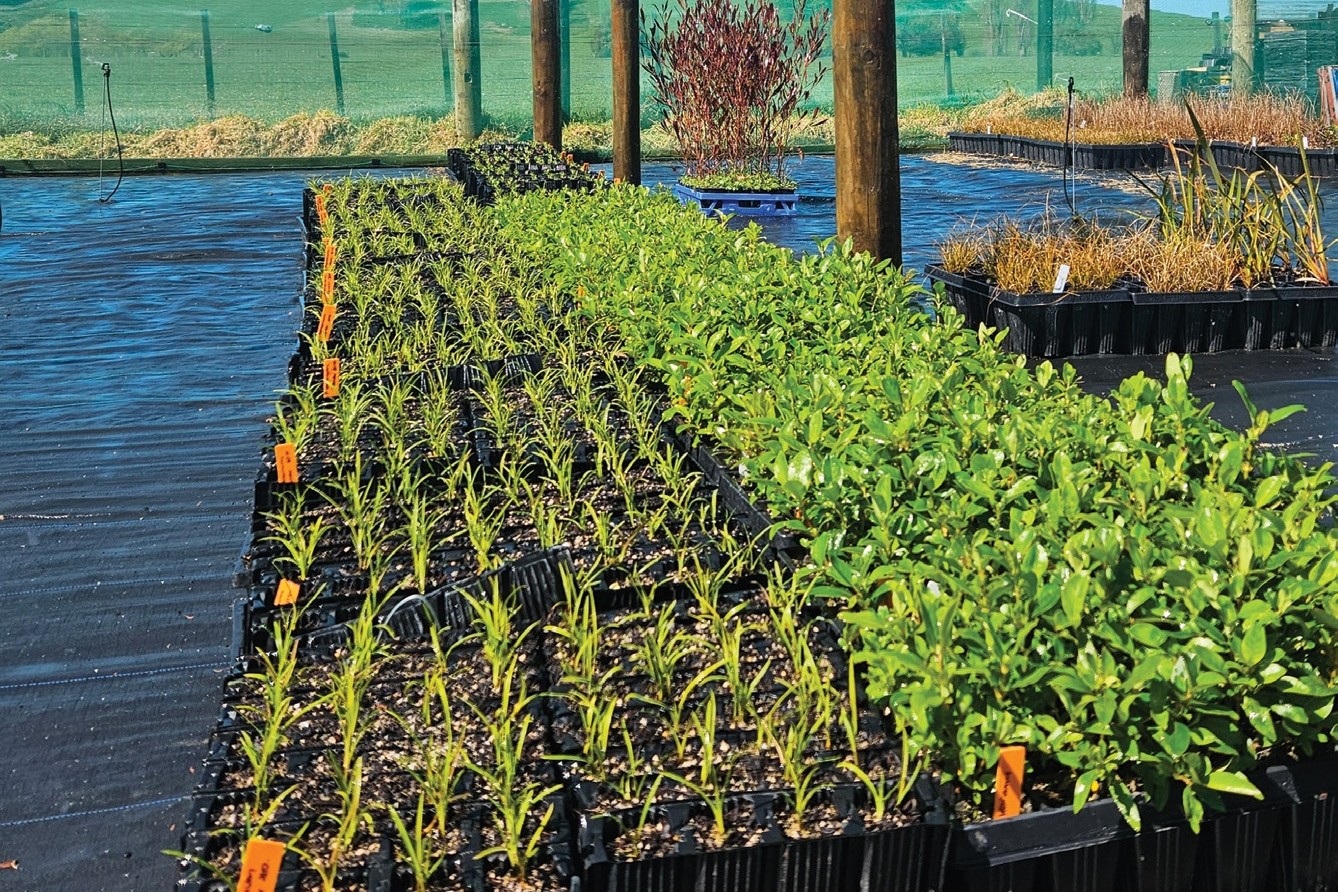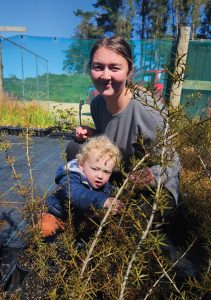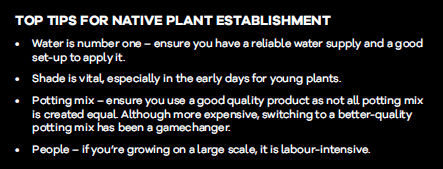Natives nurture community spirit
In a tiny pocket of rural Wairarapa, a native tree nursery is flourishing and all the proceeds are going back to the community thanks to the dedication of a band of volunteers, led by local farmer Kelsey Shannon. Rebecca Greaves reports.

 No experience growing native trees, no problem for Wairarapa farmer and mum of two, Kelsey Shannon.
No experience growing native trees, no problem for Wairarapa farmer and mum of two, Kelsey Shannon.
Kelsey is at the helm of a budding native tree nursery at Wainuioru, near Masterton, where plants are being grown for farmers, and all the profits are going back to the community.
Kelsey and her husband Ben, along with their boys Fergus, 4, and Jake, 2, are local sheep and beef farmers on the family property, alongside Ben’s parents.
With no farming background and studying towards an arts degree, Kelsey was a complete townie, by her own admission. She wasn’t enjoying the degree and dropped out to go dairy farming – she’s never looked back.
“I was dating a guy and his parents were dairy farmers. I loved working outside with the animals and once I’d done that, there was no going back.”
The Wainuioru School and Community Nursery was established in 2020 and is staffed almost entirely by community volunteers. Kelsey is the chair.
The initial seed was sown when the catchment group, the Wainuioru Community Rivercare Group, of which Kelsey was a member, secured $50,000 in funding to establish a native nursery.

“We were really lucky our council representative for Greater Wellington Regional Council put in a bid for some funding to establish a native nursery, which we got. It’s crazy how far $50,000 doesn’t go when you’re trying to do something large scale like this,” she says.
The dream was made possible thanks to a stock drive and the enormous support of local businesses, who provided labour and cost-price materials to create a suitable site and build the necessary infrastructure.
They invested in a good watering system with a timer and were fortunate to be donated water units from the Wainuioru Water Scheme.
“A couple of locals had some spare units, which they generously donated to us. Without water, we wouldn’t be able to grow plants.”
Once the initial funding was secured, they quickly had to figure out how to grow trees. There was one catch – the catchment group was unable to buy and sell plants to itself using the same funding pot. This meant they needed to create the nursery as a separate entity and sell plants locally to get started. For the last two years they have been able to sell large numbers of plants to the catchment group.
“The catchment group itself was started out here because of all the legislation coming and everyone was concerned about how it would affect us. There was a dire need to get ahead of the game, and we well and truly are now. Most farmers in our catchment are on board, and lifestylers as well.”
The catchment group has received more than $2 million in funding over the last three years thanks to a lot of hard work. Kelsey says there are many hoops to jump through and securing funding is a massive job. She pays credit to the group’s chair, Richard Johns, describing him as a key person who dedicated a tremendous amount of time towards the catchment and community.
“It pretty much looks after itself now. There is a working group, an operations manager and an admin support.”
She is quick to deflect praise from herself when it comes to the nursery, saying everyone is number one. “We wouldn’t be here without the group of ladies that turn up every week to help out and do the watering roster. Everyone pulls their weight.”
One of those women is Jane McKay, who enjoys connecting with the next generation.
“We’re all local. My kids have long finished school and I would never have got to know Kelsey otherwise. It is connecting the community.”
While most of the work is done by volunteers, they do have one paid position for 5-15 hours per week for a nursery manager – Marilyn Hunt, who used to own a nursery in Lansdowne, but they are on the hunt for the next Marilyn.
“Marilyn has so much knowledge around growing plants and she’s a key person for us.”

Kelsey herself had no experience growing trees and it’s been a steep learning curve. “There’s been lots of research, lots of stopping at nurseries and asking questions. The Department of Conservation has lots of information.”
They quickly discovered that native plants were hardy and reasonably easy care. “As long as you keep them watered and nurtured, they do their thing. We haven’t had any pest issues, yet. Natives have proven quite resilient.”
Species that grow well in the district include flaxes (they always run out), cabbage trees, toetoe, totara and manuka. Damage from pests like deer and hares mean people tend to go for the hardier species. Manuka is especially popular as it is cheap and easy to get established.
Last season was their biggest yet, with more than 50,000 plants grown, of which 36,500 went to the local catchment group. The nursery has also picked up contracts with Akura, the main native tree nursery in the Wairarapa, to contract-grow 10,000 plants for the next two years.
The overheads to set the nursery up were not cheap, but now the initial costs have been weathered the nursery is starting to turn a profit. Recently, they donated $40,000 to Wainuioru School. “That was an amazing milestone.”
Wainuioru principal, Spencer Pallister, says the money will go towards developing the school’s Forest School and outdoor learning and play spaces more fully, providing additional teacher aide hours to provide extra assistance to students, as well as being able to offer a greater range of Education Outside the Classroom opportunities.
As the funding stream for the local catchment group comes to an end after next winter’s planting, they are looking to diversify and sell to a wider audience. Kelsey’s focus is turning to spreading the word that anyone can buy trees from the nursery and qualify for the Greater Wellington Regional Council subsidy. They are able to cater for specific requests farmers have and contract-grow to exact specifications.
Kelsey says the process is to purchase the seed and outsource the initial germination.
Once the seed has been germinated and grown to a viable plant (it depends on the species how long this takes) it comes back to the nursery in a tiny plug. The busiest period is October through to Christmas, when the plants come into the nursery.
Volunteers spend countless hours potting the baby trees into larger pots or root trainers, depending on client specifications, to allow them to root out better. They are exploring more sustainable potting options to cut back on plastic waste.
Plants start going out the door to be planted onfarm about May, season dependant. Several of the slower growing species, like totara and kahikatea, stay for two years. These are repotted into larger pots after one year.
“It’s a pretty cool initiative for our community and being able to see the benefits is amazing. I love being outside and being around people. Being a stay-at-home mum, I didn’t get that. The kids get to come along and they love it. Ferg is at kindy now, but this is like Jake’s second home,” Kelsey says.
“For us, being able to have plants on hand when needed and not cart them out from town is a huge benefit. Akura is struggling to keep up with demand. Native plants will be needed more and more and it’s great to hone in on that in our community.”





